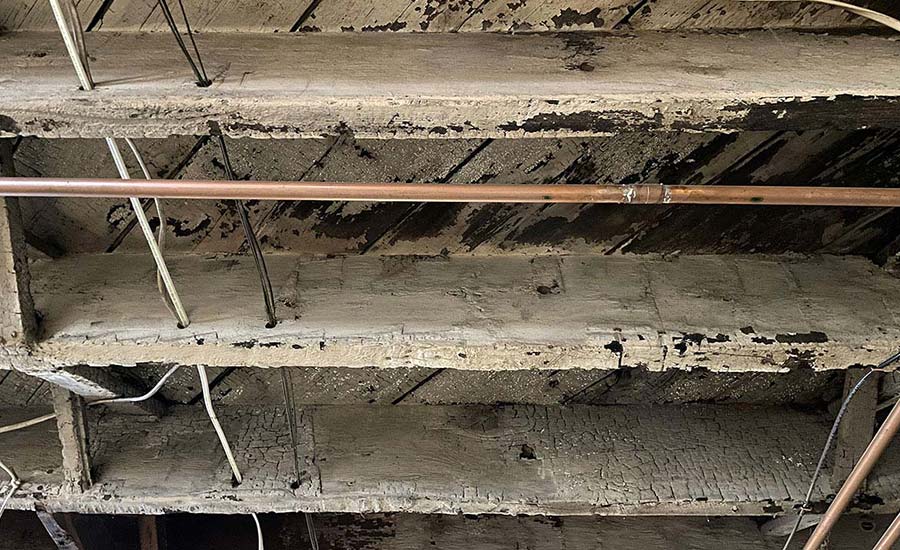In structure fires, restorers need to have a clear understanding of how fire and smoke affect wood, the nature of combustion byproducts and the characteristics of wood itself. With this knowledge, coupled with proper restorative techniques, restorers will have the necessary tools to successfully clean and restore most fire- or smoke-damaged lumber.
It is also important to realize that on a molecular level, it is impossible to remove every smoke particle or combustion byproduct that may have contaminated the material or work area. The goal is to be able to clean and deodorize smoke- or fire-damaged lumber to a point where any smoke odor is undetectable and that the odor won’t reemerge in the future.
Tips for cleaning smoke-damaged lumber
Every fire has its own DNA, as each has unique chemical composition, challenges and complexities. In some cases, restorers may need to engage an independent environmental professional (IEP) or restoration consultant to create a smoke remediation protocol. Having an IEP or expert involved who is experienced with fire and smoke restoration can help a restorer avoid their biggest nightmare: real smoke odor reemerging after the job is completed.
Before beginning the deodorizing process, workers should don proper personal protective equipment including proper rated and fit-tested respirators, coveralls, eye protection, gloves, work boots, etc.
Not all fire restoration practitioners handle deodorizing fire- or smoke-damaged lumber the same, but there are some methods that work better than others. Here are some steps that may be helpful:
- Remove all charred lumber and fire debris from the work area. This is commonly known as “source removal.” Removing as much of the odor-causing materials from the workspace as possible will greatly reduce odor concentration and cross-contamination.
- Set up environmental controls, containments and air filtration. Air scrubbers with activated carbon filters, Ultra Low Particulate Air (ULPA) filters, or HEPA filters remove airborne particulate and clean the air within the workspace. Keep in mind that air filtration alone won’t remove all odorous gases.
-
Select the proper media or method to clean the wood surfaces. The outer layer of smoke-damaged wood is what typically holds the most particulate, odor and smoke staining. It’s worth noting that every toxic chemical, VOC, heavy metal, acid and hazardous substance released by the fire in the form of smoke has now coated the wood. Removing this layer is often a necessary step in the deodorization/decontamination process. Media blasting options may include dry ice, sodium bicarbonate, walnut shells, etc. Every type of media has its pros and cons, so you need to pick the right one for the job. Avoid using sand as a blasting media, as this can cause widespread silica contamination. Soda blasting can create a considerable mess and, when used indoors, it can quickly create a white cloud so thick that you won’t be able to see your hand in front of your face. Not to mention, soda blasting resembles smoke when used, which may cause the fire department to pay you an unwanted visit. Dry ice is effective; however, it can be very dangerous if used in confined spaces with limited airflow. Dry ice evaporates into carbon dioxide and workers can quickly become sick or suffocate without proper ventilation.
Media blasting of any kind creates considerable amounts of particulate matter and wood dust, which is a known carcinogen, so proper environmental controls are crucial for the health and safety of workers and occupants. In addition, media blasting must be used very carefully as it can damage exterior felt paper, glass, electrical wiring, pipes, and other materials. - Dislodge particulate and debris from surfaces. If media blasting is used, a leaf blower, compressed air, or manual detail brushing can be used to dislodge loose, embedded or surface debris from nooks, confined pockets and surfaces, especially horizontal surfaces such as wall top plates, ceiling joists, catwalks, truss members, windowsills, etc. Since this will cause more particulate to become airborne, air scrubbers should be working in tandem.
- Thoroughly vacuum all surfaces. HEPA vacuuming all surfaces will remove any remaining dust, debris and particulate generated from the media blasting. Manufacturers of sealers and encapsulants require that surfaces be properly prepared and cleaned of dust and debris prior to application.
- Introduce heat, humidity and hydroxyls. Under certain conditions, the use of heaters with humidifiers can cause the pores within the lumber to off-gas and release trapped VOCs. Hydroxyl generators work in conjunction with the heat and humidity to create a powerful oxidizing reaction that neutralizes a wide spectrum of smoke odor gases. This three-pronged process may take a few days depending on the degree of damage, square footage of the affected area, construction of the building and other factors. Note: Hydroxyl generators may generate ozone, which is known to create toxic byproducts. Be sure to thoroughly ventilate the workspace after using hydroxyls before workers or occupants reenter.
- Fog or apply an odor counteractant over all exposed surfaces. This can be in the form of a direct wet spray application or a thermal fog. To some, this step is more of an added insurance policy which doesn’t necessarily deodorize or remove residual smoke odor but rather re-odorizes it with a strong new fragrance. The idea here is that odor counteractants provide a layer of camouflage if smoke odor finds its way out of the lumber. One problem with using heavily fragranced deodorizers is that some customers may find them to be more offensive than the smoke odor itself.
- Seal and encapsulate the affected lumber. Sealers and encapsulants are used to “lock in” or seal any residual odors from escaping into the indoor air. Here, you want to be mindful of where the encapsulant will be used, whether it may be visible in places such as an unfinished basement, attic or crawlspace, or if it will be concealed within a wall or ceiling cavity. Pigmented shellac is often used in unfinished spaces since it closely resembles the appearance of natural lumber. White sealers and encapsulants used in unfinished spaces can indicate that fire damage has been covered up. This may raise questions from future buyers and their real estate inspectors.
-
Have an IEP perform a post-remediation verification. Before you take down the containments, get written verification that your remediation work was successful. In the asbestos abatement and mold remediation industries, this is commonly known as a “clearance test.”
The purpose of a clearance test after the deodorization process is complete is to determine the efficacy of cleaning fire-related combustion particles and residues from the structural components. The post-remediation verification provides a measure of assurance within the limitations of sampling, visual/olfactory observations and scientific analysis that the structure has been remediated to as close to a pre-loss condition as possible.
The IEP will typically take air and surface samples to see if there are any elevated fire VOC’s remaining and if the cleaning was done properly. Once you pass the clearance, a third-party verification may come in handy in the event of a dispute or if you have to defend yourself against phantom odors in the future.


